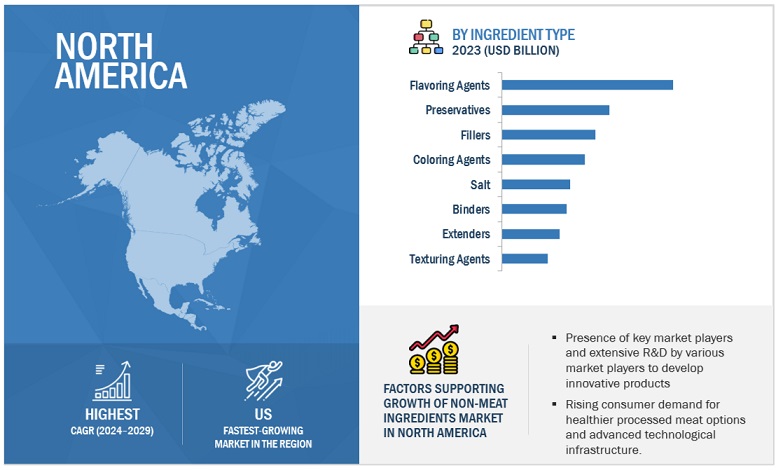The global non-meat ingredients market is undergoing a remarkable expansion, poised to reach a projected value of USD 51.1 billion by 2029, exhibiting a promising Compound Annual Growth Rate (CAGR) of 4.4%. This growth is fueled by several factors, including the rising consumption of meat, increasing urbanization, and evolving consumer preferences. Non-meat ingredients play a pivotal role in meeting the surging demand for meat products while ensuring quality, safety, and differentiation in a competitive market landscape.
Driving Factors:
Enhanced Product Quality:
Non-meat ingredients play a crucial role in enhancing the sensory attributes, food texture, flavor, and shelf-life of meat products. These ingredients facilitate the creation of unique flavor profiles, textures, and appearances, enabling manufacturers to differentiate their offerings and meet consumer expectations.
Brand Differentiation:
In an increasingly competitive market, non-meat ingredients enable meat product manufacturers to distinguish their products from competitors by creating distinct flavor profiles and textures. This brand differentiation is essential for capturing consumer attention and loyalty in a crowded marketplace.
Shelf-Life Extension:
The perishable nature of meat necessitates the use of additives and preservatives to extend its shelf life and maintain freshness. Non-meat ingredients such as preservatives and antioxidants play a crucial role in ensuring product integrity and meeting consumer expectations for quality and safety.
Market Dynamics:
Drivers:
The rising consumption of convenience meat products, driven by shifting consumer lifestyles and time constraints, is propelling the non-meat ingredients market size forward. Convenience meat products offer quick meal solutions without compromising taste or nutrition, creating a surge in demand for processed meat products enhanced with non-meat ingredients.
Restraints:
The rise in environmental and animal concerns has presented challenges for the non-meat ingredients industry, particularly in the meat processing industry. Consumers are demanding transparency and ethical sourcing practices, leading to scrutiny over the use of additives and preservatives in processed meat products.
Opportunities:
The burgeoning demand for fast-food chains presents a lucrative opportunity for the non-meat ingredients market, particularly those tailored for meat applications. As consumers seek convenient dining options without compromising taste or texture, fast-food chains rely on non-meat ingredients to maintain consistency and meet customer expectations.
Challenges:
The rise in the vegetarian and vegan population presents challenges for the non-meat ingredients market, particularly in the meat processing industry. With consumers shifting away from meat consumption, there is decreased demand for products containing non-meat ingredients, affecting market viability and profitability.
Market Segmentation:
Processed and Cured Meats:
Among various meat segments, processed and cured meats have witnessed the fastest growth in the utilization of non-meat ingredients. The demand for processed and cured meats has surged due to changing consumer lifestyles, increasing disposable incomes, and growing awareness of convenience foods.
North America:
North America is the fastest-growing market for non-meat ingredients, driven by consumer demand for processed meat products and a well-established meat processing industry.

Stringent regulations and heightened consumer awareness regarding food safety and quality standards further stimulate non-meat ingredients market growth in the region.
Key Market Players:
The non-meat ingredients companies are Kerry Group plc., Ingredion, Associated British Foods plc, International Flavors & Fragrances Inc., ADM, Cargill, BASF SE, DSM, Advanced Food Systems, Inc., and Essentia Protein Solutions. These players are focused on innovation, product development, and strategic partnerships to maintain their competitive edge in the market.
In conclusion, the global non-meat ingredients market is experiencing significant growth driven by changing consumer preferences, urbanization, and the need for quality and convenience in meat products. As the industry continues to evolve, non-meat ingredients will play an increasingly vital role in shaping the future of the food industry, catering to diverse consumer demands and market trends.